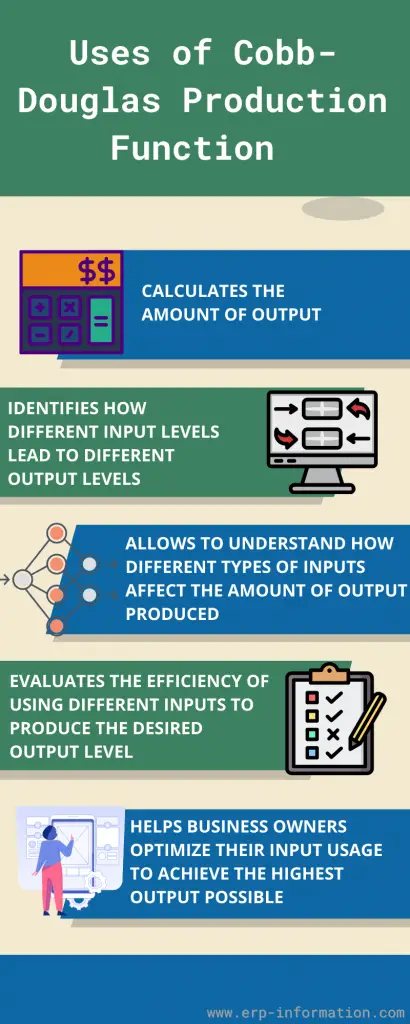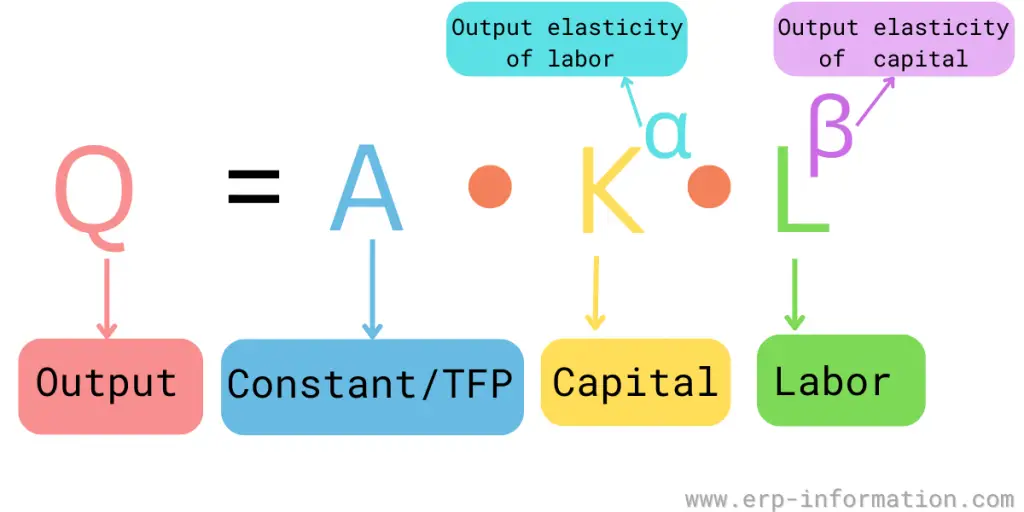The Cobb-Douglas production function is a mathematical representation that helps economists and business owners understand how much a given amount of inputs can produce output. This production function is one of the most commonly used, primarily because it is versatile.
The post will discuss all aspects of the Cobb Douglas production function. We will define it, discuss its uses and functions, examine its drawbacks and benefits, and provide real-world examples. After reading this post, you will completely understand this important economic concept!
What is the Cobb-Douglas production function?
It is a mathematical model that helps to describe the relationship between inputs and outputs in a production process. It calculates the amount of output that can be produced given a certain level of inputs and can be used to identify the most efficient use of resources.
It is often used in real-world business or economics because it is considered a very accurate model.
It was developed by economist Paul Douglas and mathematician Charles Cobb in 1920.
How does it work?
This function relates the number of inputs to a certain output level. In mathematical terms, it uses multiplicative functions to describe how different inputs are related to output. That makes it a very versatile and flexible model, as researchers can use it to analyze any input or output relationship they are interested in.
How is it used?
- It can be used to calculate the amount of output that can be produced with different combinations of inputs.
- It can be used to identify how different input levels lead to different output levels.
- It can be used to understand how different types of inputs affect the amount of output produced.
- It can be used to evaluate the efficiency of using different inputs to produce the desired output level.
- This function can help business owners optimize their input usage to achieve the highest output possible.
Cobb Douglas production function formula
In its most basic form, This function takes two inputs, capital, and labor, and calculates the resulting quantity of output as a function of those inputs. The formula is as follows,
Q=AKαLβ
where α+β=1,
K means capital (Capital represents the physical assets like buildings, machinery, and equipment
L means labor (Labour represents the workforce)
α is an exponent (elasticity of output concerning capital) and is a value between 0 and 1
β another exponent (elasticity of output concerning labor); it is equal to 1-α
A is constant and is known as the total factor productivity(TFP)
Benefits
Using the Cobb-Douglas production function in economic research and business operations has several benefits.
First, this model allows researchers and businesses to understand complex relationships between inputs and outputs more easily, which can help them make more informed decisions and optimize their processes.
Additionally, this function is often used to predict future trends in a given industry or market, which can help businesses prepare for market changes and develop new strategies.
Some other benefits are as follows.
- The Cobb-Douglas production function is a versatile mathematical model that can analyze input and output relationships.
- It is widely used in both theoretical and applied settings due to its flexibility and intuitive nature.
- It has been extensively researched and has many practical uses for business.
- The Cobb-Douglas production function is easy to use and understand.
- It provides insights into how inputs are related to outputs.
- It can help business owners optimize their production processes.
- It is a valuable tool for economic research.
Drawbacks
While there are many advantages to using the Cobb-Douglas production function, there are also some potential drawbacks.
For example,
- This model often assumes that inputs and outputs have linear relationships, which may only sometimes be true in practice.
- Additionally, as this model relies heavily on mathematical equations to capture various input and output relationships, it may not always be applicable in certain cases where more qualitative data is needed.
Seven main disadvantages
- The Cobb-Douglas production function is a complex mathematical model and may be difficult for some people to understand.
- This function is often used in economic research, making it difficult to apply in business operations.
- It is not always accurate and can produce inaccurate results if not used correctly.
- This function can be time-consuming and laborious, particularly for businesses with large amounts of data to analyze.
- It is not suitable for all types of data or inputs, so businesses need to be sure that it will suit their specific needs before using it.
- It can be expensive to implement and require purchasing specialized software or hardware.
- Some businesses find that the Cobb-Douglas production function does not give them the insights they need into their operations and choose to use other models or methods instead to analyze their data.
Despite these drawbacks, the Cobb-Douglas production function remains popular for economic research and business operations due to its versatility and ability to produce detailed insights into complex relationships between inputs and outputs.
However, it is important for businesses to carefully consider whether this function will be the best choice for their specific needs before implementing it in their operations.
Cobb Douglas production function examples
One common use of the Cobb-Douglas production function in business is to analyze different potential inputs and calculate their respective outputs. For example, a company may use this model to evaluate different raw materials or equipment types, assess their impact on output levels, and optimize production processes accordingly.
Additionally, businesses often use this function to predict future market trends and develop new strategies for growth and profitability.
Real-world examples
Some examples of real-world applications of the Cobb-Douglas production function include the following:
- The analysis of agriculture produces the following activity in developing countries
- The evaluation of technological change in manufacturing industries
- The modeling of growth processes in macroeconomic theory
- The identification of optimal production techniques in business management
5 Example industries where it is being used
- In the manufacturing industry, businesses use Cobb-Douglas production functions to help optimize their production processes and determine how many inputs are needed to produce a certain output.
- In the retail industry, Cobb-Douglas production functions are often used to model customer demand and develop strategies for improving sales.
- In the healthcare industry, It can be used to help predict future patient needs based on historical data about previous patients.
- In the transportation industry, it can be used to estimate fuel costs and better plan routes for delivery vehicles.
- In investment banking, It may be used to model the risk-return tradeoff and inform investment decisions.
FAQs
What is the production function?
A production function is a mathematical representation that describes the relationship between the quantity of output produced by a firm and the various factors of production used in that production. The most common factors of production are labor, capital, and land.
The production function can be used to calculate a firm’s total output at different levels of input use. It can also be used to identify the most efficient combination of inputs to produce a given output level.
What is Leontief’s production function?
The Leontief production function is a special production function that assumes that inputs are used in fixed proportions.
This function is often used in economic models to represent real-world situations where certain inputs (like labor and capital) are not easily interchangeable.
What is the Perfect substitutes production function?
The perfect substitutes production function is a theoretical production function that assumes two inputs (capital and labor) and two outputs (goods X and Y), so the perfect substitution between inputs leads to perfect equality between outputs.
In other words, this function states that given fixed amounts of two inputs, the output can be perfectly divided between the two outputs to achieve the same level of utility for each.
Conclusion
The Cobb-Douglas production function is a key economic concept that helps researchers and businesses understand complex relationships between inputs and outputs. This versatile model can be used in research studies, business operations, and market predictions, but it does have some limitations and drawbacks that should be considered.
Overall, it is an important tool for businesses looking to optimize their operations and achieve success in today’s dynamic economic landscape.
This article thoroughly explored Cobb-Douglas production functions, including their use, benefits and drawbacks, and some real-world examples. We hope this information has been useful and allow you to make more informed decisions about whether Cobb-Douglas production functions suit your business needs.


